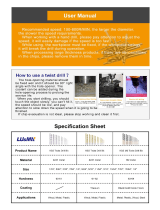
13
Regarding electric discharge in case of new batteries,
etc.
As the internal chemical substance of new batteries
and batteries that have not been used for an
extended period is not activated, the electric
discharge might be short when using them the first
and second time. This is a temporary phenomenon,
and normal time required for recharging will be
restored by recharging the batteries 2 – 3 times.
How to make the batteries perform longer.
(1) Recharge the batteries before they become
completely exhausted.
When you feel that the power of the tool becomes
weaker, stop using the tool and recharge its battery.
If you continue to use the tool and exhaust the
electric current, the battery may be damaged and
its life will become shorter.
(2) Avoid recharging at high temperatures.
A rechargeable battery will be hot immediately after
use. If such a battery is recharged immediately after
use, its internal chemical substance will deteriorate,
and the battery life will be shortened. Leave the
battery and recharge it after it has been cooled for
a while.
CAUTION
䡬 If the battery has been heated right after operation
(or due to sunlight, etc.), the charger’s pilot lamp
may not light in red. In such a case, first let the
battery cool, then start charging.
䡬 When the pilot lamp flickers in red quickly (at 0.2-
second intervals), check for and take out any foreign
objects in the charger’s battery installation hole. If
there are no foreign objects, it is probable that the
battery or charger is malfunctioning. Take it to your
authorized Service Center.
䡬 Since the built-in micro computer takes about 3
seconds to confirm that the battery being charged
with UC24YFB is taken out, wait for a minimum of
3 seconds before reinserting it to continue charging.
If the battery is reinserted within 3 seconds, the
battery may not be properly charged.
PRIOR TO OPERATION
1. Mounting and dismounting of the bit.
(1) Mounting the bit
After inserting a drill bit into the keyless chuck,
firmly grasp the ring and tighten the sleeve by
turning it toward the right (in the clockwise direction
as viewed from the front). (See Fig. 4)
䡬 If the sleeve becomes loose during operation, tighten
it further. The tightening force becomes stronger
when the sleeve is tightened moreover.
(2) Dismounting the bit
Firmly grasp the ring and loosen the sleeve by
turning it toward the left (in the counterclockwise
direction as viewed from the front). (See Fig. 4)
2. Selecting the appropriate drill bit
䡬 When boring concrete or brick
Use the drill bits specified in the Optional
Accessories.
䡬 When boring metal or plastic
Use an ordinary metalworking drill bit.
䡬 When boring wood
Use an ordinary woodworking drill bit.
However, when drilling 6.5 mm or smaller holes,
use a metalworking drill bit.
3. Confirm that the battery is mounted correctly.
4. Confirm the direction of bit rotation (Fig. 5)
The bit rotates clockwise (viewed from the rear
side) by pushing the R-side of the push button. (Fig.
5-a)
The L-side of the push button is pushed to turn the
bit counterclockwise. (Fig. 5-b)
The motor does not rotate if the push button is set
to the center position. (Fig. 5-c)
5. Installing the side handle and handle joint (Fig. 6)
A Side handle and handle joint can be installed on
either side of the tool for right or left handed use.
To install the side handle and handle joint, thread
it into the socket on the desired side of the tool
and tighten it securely.
6. Attaching the angle unit. (Optional accessory)
(1) Removing keyless chuck from impact drill (Fig. 7)
䡬 To remove the keyless chuck from the impact drill,
open the keyless chuck jaws as far as possible and
turn out the locking screw (left hand thread). This
screw locks the keyless chuck to the spindle. Install
the hex. bar wrench into the keyless chuck. Place
the accessory wrench in the hexagonal opening of
the angle unit spindle. Tightly restrain the impact
drill on a firm base. Turn the keyless chuck until
the wrench is at about a 30° angle to the bench
top and strike the wrench sharply with a hammer
so the keyless chuck turns in the counterclockwise
direction (viewed from the front side). This should
loosen the keyless chuck from the spindle which
has a right hand thread and you will be able to
remove the keyless chuck by hand.
CAUTION:
If the keyless chuck cannot be removed by striking
the wrench, don’t strike the wrench forcibly and
send the impact drill to a HITACHI AUTHORIZED
SERVICE CENTER.
(2) Attaching the angle unit.
䡬 After removing the keyless chuck, engage the
coupling to the impact drill spindle. Fit the joint
sleeve to the gear cover, attach the angle unit to
the other end of the joint sleeve, and turn the angle
unit slightly in either direction so the hex. hole in
the coupling engages the hex. portion of the angle
unit spindle. Adjust the direction of the angle unit
and tighten the joint sleeve by clamping bolts.
Tighten two clamping bolts equally and gradually
in turn with a torque of 686-784N·cm (70-80kgf·cm)
(extent of force which can be subjected by only a
wrist with the open end wrench provided to tight
clamping bolts.). (Fig. 8)
䡬 To operate the angle unit at low speed, attach the
keyless chuck to the angle unit spindle at the side
marked “LOW” and secure the locking screw. At
this setting, the drilling speed is decreased to about
70% and the drilling torque is increased to about
150%. (Fig. 9)
䡬 To operate the angle unit at high speed, attach the
keyless chuck to the angle unit spindle at the side
marked “HIGH” and secure the locking screw. At
this setting, the drilling speed is increased to about
150% and the drilling torque is decreased to about
70%. (Fig. 9)


















